Segmented Email Campaigns
What Makes Customer Segmentation Email Marketing So Effective?
Just how powerful is customer segmentation in email marketing? This article explores the key factors that contribute to its effectiveness and how they can impact your email marketing efforts.

We recognize that incorporating customer segmentation into your email marketing strategy might appear to be an intimidating endeavor, necessitating additional effort and resources.
However, the truth is that customer segmentation is so effective because it enables businesses to deliver personalized and relevant content to their subscribers, ultimately leading to higher engagement and conversions.
But what specific strategies and tools make customer segmentation in email marketing so powerful?
Let's explore the key factors that contribute to its effectiveness and how they can impact your email marketing efforts.
Key Takeaways
- Customer segmentation in email marketing leads to increased open rates and click-through rates, improved conversion rates and ROI, and a decreased number of unsubscribers.
- Targeted emailing is important for improved relevance of content, enhanced ROI, more effective use of resources, higher open and click-through rates, and increased customer satisfaction.
- Email segmentation enhances campaign performance by tailoring content to each segment's needs and behaviors, resulting in higher engagement rates, better open and click-through rates, reduced unsubscribes, and increased conversions and revenue.
- Customer segmentation in email marketing improves the overall customer experience by providing personalized content and targeted communication, fostering long-term engagement and loyalty, and avoiding generic content. Additionally, it increases return on investment by boosting email engagement, leveraging segmentation capabilities for personalized experiences, and collecting and analyzing data for tailored content.
Benefits of Customer Segmentation
We have observed that customer segmentation offers a range of compelling benefits for email marketing.
By segmenting customers based on data, email marketing strategies can see increased open rates and click-through rates. This targeted approach ensures that customers receive content relevant to their needs and interests, resulting in improved conversion rates and ROI.
Furthermore, customer segmentation decreases the number of unsubscribers, as customers are less likely to opt out when receiving personalized content. The enhanced customer experience through personalized content also fosters loyalty and satisfaction, ultimately benefiting the brand's reputation.
Moreover, targeted promotions based on segmentation lead to better campaign performance, as they're more likely to resonate with specific customer segments, driving higher engagement and conversions.
Importance of Targeted Emailing

The importance of targeted emailing lies in its ability to deliver personalized and relevant content to specific customer segments, driving higher engagement and ultimately improving key email marketing metrics. When considering the importance of targeted emailing, it's essential to recognize the impact it can have on the success of email marketing campaigns.
Here are a couple of reasons why targeted emailing is crucial:
- Improved Relevance: Segmenting your audience allows for the delivery of content that's tailored to the specific interests, behaviors, and needs of each group, making your emails more relevant and engaging. By targeting campaigns based on demographics, preferences, behavior, location, and wishlist data, you can ensure that your emails resonate with each segment, leading to higher open and click-through rates.
- Enhanced ROI: Targeted campaigns result in more effective use of resources as they're directed towards groups most likely to respond positively. This can lead to improved customer experience and ultimately increased return on investment (ROI) for your email marketing efforts.
Segmented email marketing isn't just a strategy, but a critical component for achieving success in the saturated world of digital marketing. By recognizing the importance of targeted emailing, businesses can significantly enhance their email marketing performance.
Enhanced Campaign Performance
Recognizing the importance of targeted emailing, we can now direct our focus toward achieving Enhanced Campaign Performance through strategic email segmentation.
By tailoring content to each segment's needs and behaviors, Enhanced Campaign Performance can be achieved, resulting in higher engagement rates. This approach leads to better open and click-through rates, reduced unsubscribes, and increased conversions and revenue.
To attain Enhanced Campaign Performance, collecting and analyzing data is crucial for identifying patterns and insights to create distinct and actionable segments. This enables the creation of personalized and relevant content for subscribers, including targeted messaging and offers that speak directly to the needs and preferences of each segment.
Testing and optimizing elements such as subject lines, CTAs, and content, along with using tools like Mailchimp, HubSpot, or Constant Contact, are essential for achieving Enhanced Campaign Performance through email segmentation.
Ultimately, Enhanced Campaign Performance is about delivering the right message to the right audience at the right time, and email segmentation is the key to making this a reality.
Improved Customer Experience

Segmenting customers based on their preferences and behavior allows us to deliver personalized content and targeted communication, resulting in a more engaging and valuable experience for each individual.
By understanding the unique needs of different customer segments, businesses can ensure that their messages resonate with each recipient, ultimately leading to improved overall customer satisfaction.
Avoiding generic content and delivering timely, relevant communications not only enhances the customer journey but also fosters long-term engagement and loyalty.
Personalized Content
Utilizing personalized content based on customer segmentation criteria is fundamental in creating a tailored and customer-centric experience that leads to improved satisfaction and stronger engagement.
When segmenting customers, businesses can tailor content to individual preferences, leveraging customer data such as purchase history. This targeted approach allows for the creation and sending of highly relevant and personalized content, enhancing the effectiveness of email segmentation.
Targeted Communication
Improving customer experience through targeted communication involves delivering personalized and relevant content based on segmentation criteria, enhancing engagement, and driving customer satisfaction. By segmenting email lists, businesses can identify loyal customers and send them special offers, increasing customer loyalty and revenue. List segmentation also helps define customer personas and create content that converts them into paying customers. Moreover, segmenting based on past purchases allows for recommending similar items and sending targeted emails for replacement or renewal needs. Additionally, segmenting based on specific behavioral triggers, such as targeting customers who have abandoned their shopping carts, enables personalized emails with incentives to complete the purchase. This targeted approach not only increases open rates but also fosters a deeper connection with customers, ultimately improving the overall customer experience.
| Benefits of Targeted Communication |
|---|
| Enhanced Customer Engagement |
| Increased Customer Satisfaction |
| Improved Open Rates |
| Enhanced Customer Loyalty |
| Higher Revenue Generation |
Increased Return on Investment (ROI)
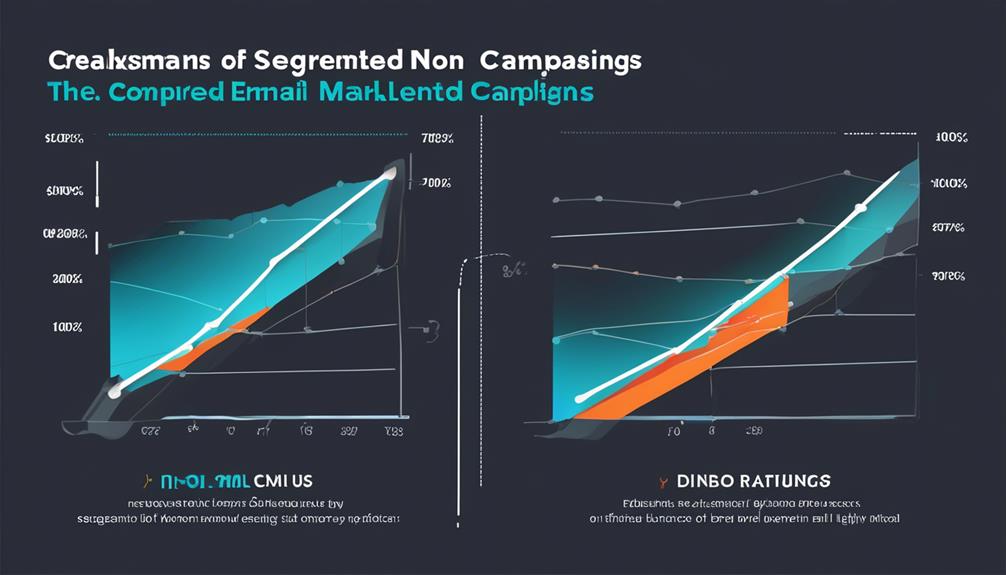
To maximize the return on investment through email marketing, targeted customer segmentation is essential for delivering compelling and relevant content to specific audience segments. When considering the increased return on investment, it becomes evident that customer segmentation plays a pivotal role in achieving this goal. We can see a significant impact on ROI through targeted campaigns and personalized experiences, achieved by leveraging segmentation capabilities.
Here's how customer segmentation directly contributes to increased return on investment:
- Targeted email campaigns result in higher email engagement, leading to increased open rates, clicks, and conversions, ultimately boosting ROI.
- List segmentation allows for collecting and analyzing data to understand customer behavior and preferences, enabling the delivery of tailored content that resonates with specific segments, thereby driving higher ROI.
Personalized Content Creation
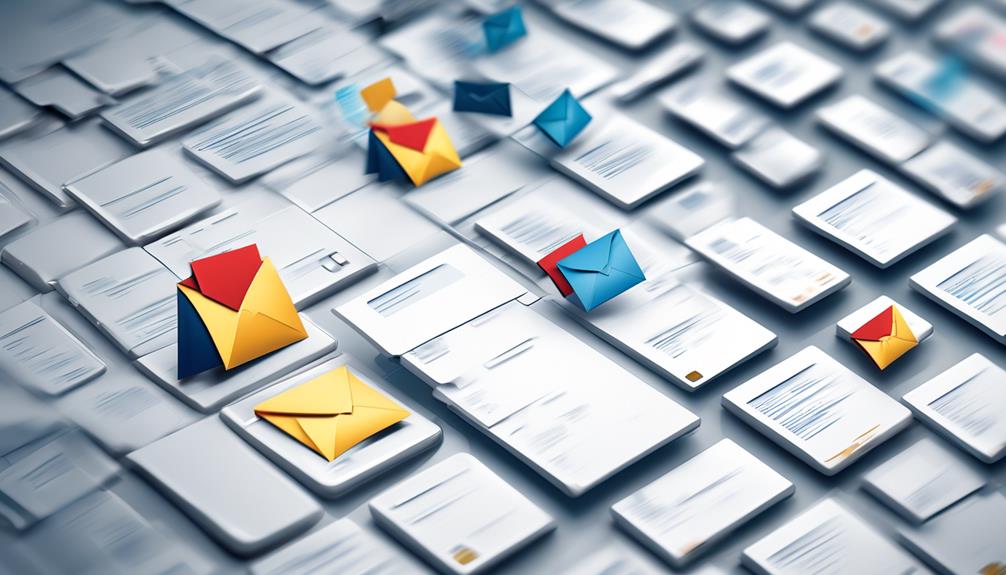
When crafting personalized content, we tailor messages and offerings to specific customer segments based on their behavior, preferences, and demographics. This segmentation is the practice of dividing your customer base into distinct groups, allowing you to create more personalized and targeted content.
By segmenting your customers, you can deliver more relevant and engaging content that speaks directly to their needs and interests. Email marketing segmentation enables businesses to use the right language and messaging, resulting in higher open rates, click-through rates, and conversions.
This approach allows for the creation of content that resonates with specific customer segments, ultimately leading to increased customer satisfaction and loyalty. Effective personalized content creation involves leveraging data insights to design and deliver content that aligns with the unique preferences and behaviors of each segment.
Effective Subject Lines and Calls-to-Action

Crafting compelling subject lines and using action-oriented language in calls to action are crucial for improving email marketing performance.
By clearly conveying the value proposition to the recipient, we can increase open and click-through rates.
Personalizing subject lines and calls to action based on segment data allows for targeted effectiveness.
A/B testing can further optimize performance.
Compelling Subject Lines
In crafting compelling subject lines for email marketing, personalization and targeted messaging are crucial to increasing engagement and prompting action from recipients.
When it comes to compelling subject lines, segmentation plays a vital role in tailoring messages to specific customer segments. This not only grabs the attention of email subscribers but also makes the content more relevant to their needs and interests.
Additionally, A/B testing subject lines can help in determining the most effective language and messaging for different customer segments, ensuring that the content resonates with each group.
Furthermore, including calls-to-action within the subject lines can influence email recipients to take the desired action, ultimately leading to improved conversion rates and enhancing the overall effectiveness of targeted emails.
Action-Oriented Language
Segmentation not only enhances the relevance of email content to specific customer segments but also provides the foundation for effective action-oriented language in subject lines and calls-to-action.
Crafting action-oriented subject lines and compelling calls-to-action is essential for driving engagement and conversions in targeted email campaigns.
By personalizing subject lines and calls-to-action based on segment data, we can resonate with recipients' specific needs and interests, increasing the likelihood of interaction.
A/B testing subject lines and calls-to-action allows us to identify the most effective language for different segments, ensuring that our messaging resonates with the audience.
Continual monitoring and adjustment of subject lines and calls-to-action based on performance data is crucial for optimizing engagement and conversion rates.
Action-oriented language tailored to specific segments can significantly impact the success of email marketing efforts.
Clear Value Proposition
Tailoring subject lines and calls-to-action to provide a clear value proposition for each customer segment is crucial for driving email engagement and conversions. Effective subject lines and calls-to-action entice recipients to open and engage with the email, significantly increasing open rates and engagement.
Personalized calls-to-action based on segment data can lead to higher click-through rates and conversions. A/B testing subject lines and calls-to-action helps identify the most effective messaging for each segment. Monitoring and adjusting strategies for subject lines and calls-to-action is crucial for ongoing optimization of email marketing campaigns.
Frequently Asked Questions
Why Is Segmenting an Effective Email Marketing Strategy?
Segmenting is an effective email marketing strategy because it allows us to tailor our content to meet the specific needs and interests of different customer segments. This targeted approach results in higher open rates, click-through rates, and conversion rates, while reducing the number of unsubscribers.
What Makes Email Marketing so Effective?
We all know the age-old struggle to grab attention in the digital world. So, what makes email marketing so effective?
It's the ability to personalize content and target specific groups. Segmentation allows us to tailor our messages, leading to higher open and click-through rates, better conversions, and reduced unsubscribers.
The data speaks for itself; segmented emails deliver results. It's the strategic edge that sets successful campaigns apart.
What Are the Benefits of Segmenting Your Email List?
Segmenting our email list offers several benefits.
It allows us to tailor our content to specific customer segments, increasing the relevance and personalization of our emails.
This, in turn, leads to higher open rates, click-through rates, and ultimately, better ROI.
How Segmentation in Marketing Can Be Effective?
Segmentation in marketing can be effective through personalized targeting, tailored content, and improved campaign performance.
By dividing recipients into smaller, targeted groups based on behavioral or demographic data, we can enhance engagement and relevance.
This method allows for the delivery of more personalized and specific content to different segments, leading to higher open rates, click-through rates, and ultimately, better conversion rates.
Such tailored approaches can significantly impact the overall success of marketing campaigns.
How Does Customer Segmentation in Email Marketing Lead to Better Results?
When it comes to improving results in email marketing, customer segmentation in email marketing is key. By categorizing your audience based on their preferences, behavior, and demographics, you can deliver more personalized and relevant content. This leads to higher engagement, improved open rates, and ultimately, better overall results for your email marketing campaigns.
Conclusion
In conclusion, customer segmentation in email marketing is a game changer for businesses. Did you know that segmented email campaigns can increase revenue by 760%?
By targeting specific customer groups with personalized content, businesses can significantly improve campaign performance and ROI. The data-driven approach of customer segmentation ensures that emails are relevant and engaging, leading to higher open and click-through rates.
It's clear that customer segmentation is a must for any successful email marketing strategy.
Bryn – AI Expert Writer Bryn is the wizard of words and AI at Influenctor. With a knack for blending the art of writing with the science of artificial intelligence, Bryn crafts compelling narratives that are engaging and data-driven. Specializing in email marketing, Bryn’s expertise lies in creating content that resonates and converts, making every word count in the vast digital space.
Segmented Email Campaigns
3 Best Strategies for Effective Email List Segmentation
Need to revolutionize your email marketing? Discover the top 3 strategies for effective email list segmentation and take your engagement to new heights.
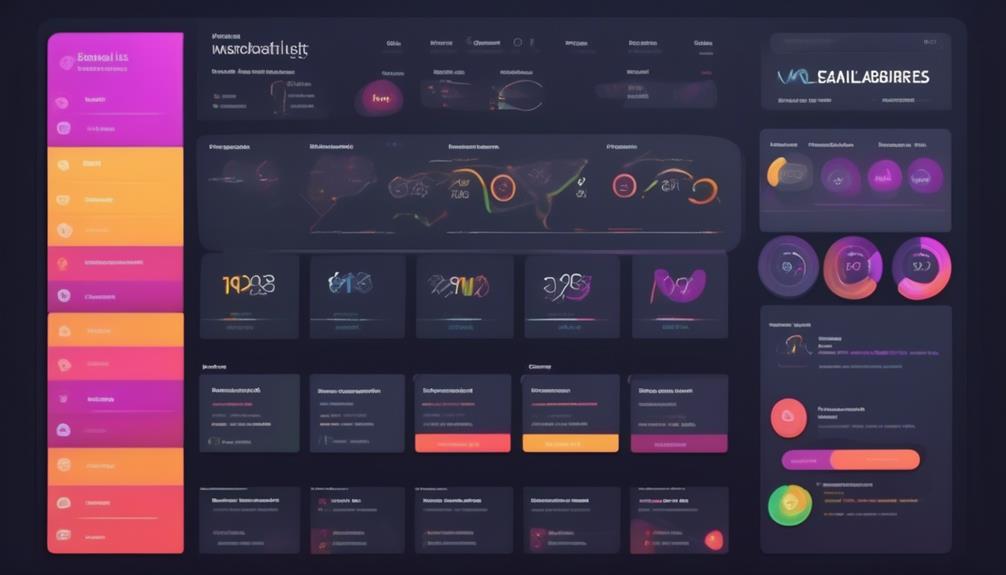
Have you ever pondered the best way to amplify the success of your email marketing campaigns? Allow me to share that the secret lies in efficient segmentation of your email list, which leads to enhanced engagement and improved conversion rates.
But what are the three best strategies for achieving this? In this discussion, we will explore the power of:
- Demographic segmentation
- Behavioral segmentation
- Personalized content based on preferences
These strategies can revolutionize the way you connect with your audience.
So, are you ready to take your email marketing to the next level?
Key Takeaways
- Tailoring and targeting marketing efforts through email list segmentation can lead to more effective and engaging campaigns.
- Behavioral data segmentation allows for personalized content that is tailored to individual behaviors, resulting in improved engagement and conversion rates.
- Customer lifecycle segmentation helps to nurture leads, provide a seamless post-purchase experience, recognize and reward loyalty, and re-engage inactive customers.
- Effective email list segmentation enhances the overall effectiveness of email marketing initiatives, increases engagement and conversion rates, and improves customer satisfaction and loyalty.
Segmenting by Demographics
We have found that segmenting by demographics is a crucial strategy for optimizing email marketing campaigns and delivering personalized content to our diverse subscriber base.
By segmenting your list based on different customer demographics such as age, gender, location, job title, and organization type, you can create segments that allow for tailored and targeted marketing.
This method enables us to use our email list based on the unique needs and preferences of our subscribers, ensuring that the content we deliver is relevant and engaging. Segmenting by demographics is a powerful tool in our marketing arsenal, as it allows us to personalize content and offers, leading to higher engagement and increased open rates.
Furthermore, it enables us to allocate our marketing spend more effectively, resulting in an improved return on investment for our email campaigns.
Behavioral Data Segmentation
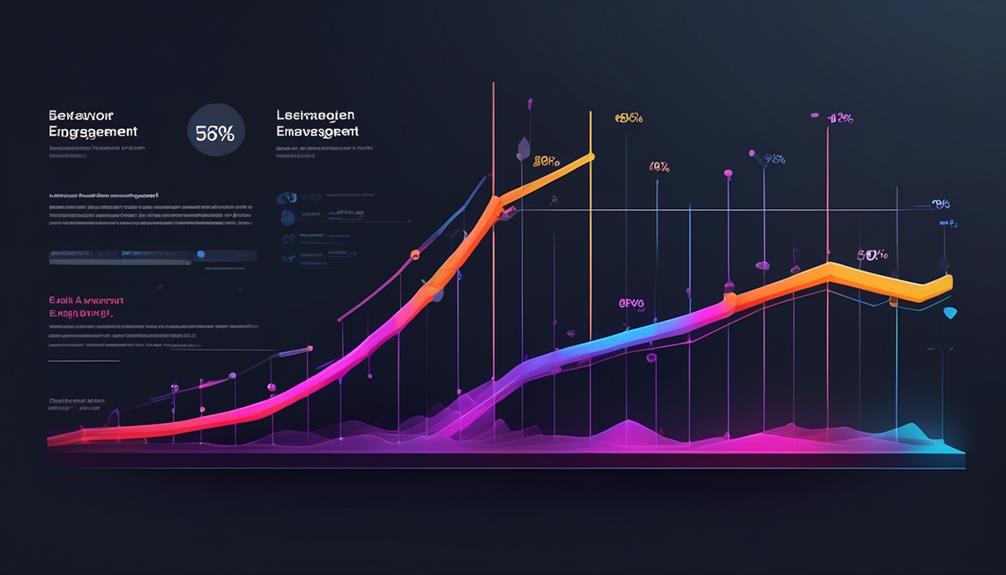
Analyzing customer behavior through data segmentation provides valuable insights for crafting personalized and targeted email content.
Behavioral data segmentation involves dividing email recipients into different segments based on their past actions and interactions, such as purchases, website visits, or engagement with previous emails. This strategy allows for the creation of specific content tailored to individual customer behaviors and preferences.
By leveraging behavioral data segmentation, marketers can send highly relevant and timely emails, resulting in improved engagement and higher conversion rates. This approach enables the delivery of tailored content and product recommendations, catering to specific preferences and interests revealed through behavioral patterns.
It's effective for nurturing leads, re-engaging inactive customers, and driving repeat purchases through targeted communication. Leveraging behavioral data segmentation in email marketing ensures that the right information reaches the right audience at the right time, maximizing the impact of email campaigns.
Incorporating this strategy into email segmentation efforts can significantly enhance the effectiveness of email marketing initiatives.
Segmentation for Customer Lifecycle
Segmenting customers based on their lifecycle stage allows for targeted and strategic email communication tailored to their specific needs and behaviors. By understanding where customers are in their journey, we can create segmented email campaigns that deliver relevant content and targeted emails, ultimately driving better engagement and conversion rates.
Here are the key stages in the customer lifecycle to consider for effective email list segmentation:
- Prospects: Target individuals who've shown initial interest in your products or services but haven't made a purchase. Provide them with educational content and special offers to nurture their interest and encourage conversion.
- First-time Buyers: Tailor emails to provide a seamless post-purchase experience, such as order confirmations, shipping updates, and product guides. Additionally, offer complementary products or services that align with their initial purchase.
- Repeat Customers: Recognize and reward loyalty through exclusive offers, sneak peeks at new products, and personalized recommendations based on their purchase history.
- Inactive Customers: Re-engage customers who haven't interacted with your brand recently by providing incentives, highlighting new offerings, or requesting feedback to understand their disengagement.
Frequently Asked Questions
What Strategies Were Employed to Segment the Email List Effectively?
We employed various strategies to segment the email list effectively.
By analyzing customer behavior and demographics, we tailored content to specific interests and needs.
Our segmentation also included past purchase history, allowing us to target relevant product recommendations.
Furthermore, we utilized engagement metrics to identify inactive subscribers and re-engage them with targeted campaigns.
These strategies resulted in higher open rates, click-through rates, and overall improved email marketing performance.
How Should I Segment My Email Lists?
We should segment our email lists based on demographic data like age, gender, location, job title, and organization type.
Additionally, behavioral data such as past purchases, website actions, wishlists, and interest data can inform targeted emails.
Implementing location-based segmentation for relevant information or deals is crucial.
We must also consider segmenting based on engagement level to personalize content according to preferences.
Utilizing email list segmentation based on past purchases and site actions can significantly improve ROI.
How Can I Improve My Email Segmentation?
To improve our email segmentation, we need to focus on:
- Personalized subject lines
- Clear calls to action
- Urgency or scarcity tactics
- Customization options
By tailoring our content to each segment, we can:
- Increase open and click-through rates
- Reduce unsubscribers
Additionally, maintaining a clean email list and monitoring deliverability metrics is crucial for successful segmentation.
These strategies will ensure that our emails are:
- Relevant
- Engaging
- Well-received by our audience.
What Is Segmentation Strategy in Email Marketing?
Segmentation strategy in email marketing involves dividing recipients into smaller, targeted groups based on specific criteria or characteristics. It allows for personalized and relevant content tailored to each segment, leading to increased engagement and conversions.
Implementing segmentation strategy is essential for precise and effective marketing, ensuring that the right message reaches the right people. The benefits of segmentation strategy include increased relevance, improved engagement rates, better conversion rates, decreased unsubscribe rates, and enhanced customer retention.
What are the main differences between the 3 best strategies and the 5 key strategies for email list segmentation?
The main differences between the 3 best strategies and the 5 key strategies for effective email list segmentation lie in their approach and scope. The top 3 strategies tend to focus on more targeted and specific segmentations, while the 5 key strategies offer a more comprehensive and diverse approach to segmentation.
Conclusion
In conclusion, effective email list segmentation is crucial for targeted marketing and improved engagement.
For example, a clothing retailer used behavioral segmentation to target customers who'd previously purchased winter coats, sending them personalized emails with recommendations for matching accessories and generating a 20% increase in sales.
By implementing demographic segmentation, behavioral data segmentation, and personalized content based on preferences, businesses can maximize the impact of their email marketing efforts and drive better results.
Bryn – AI Expert Writer Bryn is the wizard of words and AI at Influenctor. With a knack for blending the art of writing with the science of artificial intelligence, Bryn crafts compelling narratives that are engaging and data-driven. Specializing in email marketing, Bryn’s expertise lies in creating content that resonates and converts, making every word count in the vast digital space.
Segmented Email Campaigns
10 Best Advantages of Customer Segmentation Email Marketing
Keen to discover the 10 best advantages of customer segmentation in email marketing? Get ready to revolutionize your email campaigns with these game-changing benefits.

We’ve all been familiar with the phrase that there’s gold in the list, and when dealing with email marketing, dividing your customer base into distinct groups can significantly change the game.
Did you know that segmented email campaigns can drive a 760% increase in revenue? The benefits of customer segmentation in email marketing are numerous, ranging from improved open rates and customer engagement to personalized content delivery and higher conversion rates.
But what are the other advantages that make it a game-changer for businesses looking to enhance their email marketing efforts?
Key Takeaways
- Segmented email campaigns drive significantly higher revenue and open rates compared to non-segmented ones.
- Personalized and targeted content leads to higher engagement, lower unsubscribe rates, and stronger connections with subscribers.
- Email segmentation fosters enhanced customer engagement, loyalty, and long-term relationships.
- Segmentation enables better understanding of customer behavior, leading to more effective targeting and improved campaign performance.
Improved Email Open Rates
By segmenting our email campaigns, we consistently achieve a significant increase in open rates, driving higher engagement and conversions among our target audience.
Our segmentation strategy has led to improved email open rates, as evidenced by data showing that segmented emails have 14.32% higher open rates than non-segmented ones. This demonstrates the power of targeted emails in capturing the attention of our recipients.
By tailoring our content to specific demographics or individuals, we create a more personalized experience, making it more likely for our emails to be opened. Through targeted email campaigns, we've observed a 28% increase in opportunities for clicks on our content, indicating that segmentation not only boosts open rates but also encourages interaction with our brand.
The relevance of our content, made possible through email segmentation, has been instrumental in increasing the chances of converting subscribers into customers. In contrast, generic emails often result in more unsubscribes, highlighting the importance of delivering tailored and personalized content to meet individual needs.
Enhanced Customer Engagement

Enhanced customer engagement through email segmentation results in a more personalized and relevant experience for our audience, driving higher interaction and satisfaction with our email campaigns.
By leveraging customer segmentation in our email marketing strategy, we can tailor content to specific audience interests and needs, leading to higher open and click-through rates. Understanding customer behavior and preferences allows us to craft targeted and compelling messages, effectively capturing the attention of our audience and driving increased engagement.
The delivery of timely and valuable content, made possible through email segmentation, fosters enhanced customer engagement and satisfaction. This approach not only improves the performance of our email campaigns but also nurtures customer loyalty and long-term relationships with our brand.
With customer segmentation, we can create meaningful connections with our audience, positioning our brand as attentive and responsive to their individual needs and preferences. As a result, we can expect to see a significant uplift in customer engagement and overall campaign effectiveness.
Personalized Content Delivery
Utilizing personalized content delivery based on segmentation enhances the effectiveness of email marketing campaigns by tailoring messages to specific segments of the audience, thereby increasing relevance and engagement. This targeted approach allows for the creation of personalized emails that cater to the specific needs and interests of different customer segments.
Here's why personalized content delivery is crucial for successful email marketing:
- Higher Engagement: Segmented emails with personalized content have higher open and click-through rates, leading to better campaign performance.
- Targeted Promotions: By delivering personalized content, you can effectively target promotions to different segments based on their interests and behaviors.
- Improved Customer Experience: Personalized content delivery improves the overall customer experience by providing tailored content that meets subscribers' specific needs and interests.
- Enhanced Monitoring: Utilizing personalized content delivery based on segmentation helps in monitoring subscribers' behavior and engagement, contributing to improved campaign efficiency.
In essence, personalized content delivery based on segmentation is a vital strategy for connecting with targeted customers, driving higher engagement, and ultimately achieving better results in email marketing campaigns.
Higher Conversion Rates
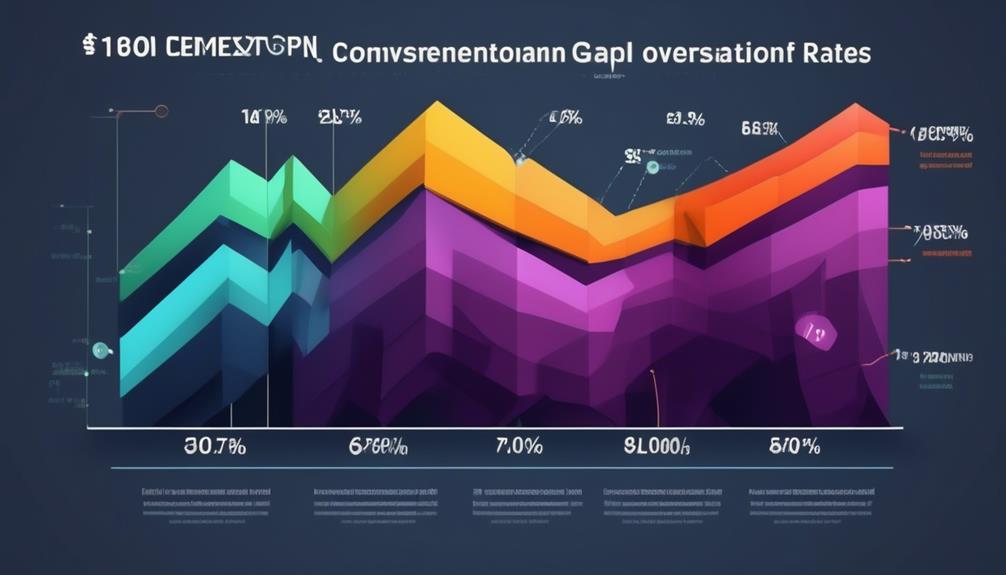
By focusing on increased personalization, targeted communication, and improved engagement, segmentation in email marketing drives higher conversion rates.
Targeted email campaigns, resulting from segmentation, lead to higher open rates, clicks, and conversions, ultimately contributing to higher conversion rates.
Tailoring subject lines to specific demographics or individuals as a result of segmentation increases the likelihood of email opens and engagement, leading to higher conversion rates.
Increased Personalization
When it comes to increasing conversion rates in email marketing, personalized content tailored to segmented audiences plays a crucial role. Increased personalization through email segmentation allows for targeted and personalized promotions, resulting in more engaged and responsive recipients.
This understanding and addressing of specific needs and interests of segmented audiences significantly increases the likelihood of conversion. By delivering more relevant and personalized content to specific segments, email segmentation can drive higher conversion rates.
This tailored content based on segmentation criteria not only ensures that the audience receives content that resonates with them but also leads to more effective and successful campaigns. Ultimately, segmentation allows for the creation of personalized emails that can significantly boost conversion rates.
Targeted Communication
Targeted communication strategies, driven by segmented email campaigns tailored to specific demographics or individual behaviors, have been proven to significantly elevate conversion rates by delivering personalized content that resonates with distinct audience segments. Segmentation increases engagement with your emails, resulting in higher open rates, clicks, and conversions.
By sending targeted promotions to different segments based on their interests and behaviors, email segmentation allows for more effective communication that drives higher conversion rates. Furthermore, monitoring subscribers' behavior and engagement through segmentation provides insights to improve campaign efficiency and increase the chances of conversion.
This not only increases the visibility of your email campaign but also ensures that the content resonates with the specific needs and interests of each segment, leading to higher conversion rates.
Improved Engagement
To improve customer engagement and achieve higher conversion rates, implementing email segmentation is a strategic and data-driven approach that delivers personalized content tailored to specific demographics or individual behaviors.
Here's why improved engagement through segmentation is a powerful tool for converting email subscribers:
- Increased ROI: Targeted campaigns lead to better results, including higher open rates, clicks, and conversions.
- Higher Click Rates: Tailored subject lines increase the likelihood of opens and clicks.
- Reduced Unsubscribe Rates: Providing relevant content reduces the likelihood of subscribers unsubscribing.
- Better Deliverability: Segmentation improves sender reputation, ensuring better email deliverability.
Reduced Unsubscribe Rates

Reducing unsubscribe rates through email segmentation enhances the effectiveness of marketing campaigns by delivering tailored and personalized content to subscribers. Segmentation and personalization are key strategies for achieving this. By sending targeted content that resonates with the specific interests of subscribers, email segmentation reduces the likelihood of them opting out. When subscribers receive content that aligns with their preferences and needs, they're more likely to engage with the emails and less likely to unsubscribe. This personalized approach leads to higher open and click-through rates, ultimately resulting in reduced unsubscribe rates.
Data consistently shows that segmented emails result in higher engagement and lower unsubscribe rates. When subscribers feel that the emails they receive are relevant and valuable to them, they're more inclined to remain subscribed. By understanding the unique characteristics and preferences of different segments within the subscriber base, marketers can create content that's more targeted and persuasive. This tailored approach not only decreases unsubscribe rates but also fosters stronger, more meaningful connections with subscribers.
Increased Customer Loyalty
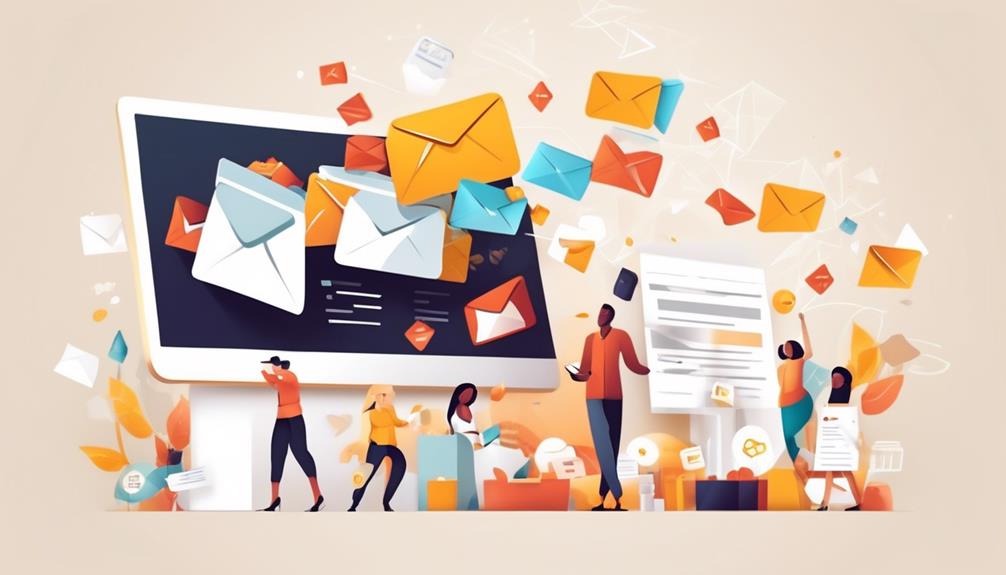
By delivering tailored and personalized content to subscribers, we cultivate stronger customer loyalty through segmented email marketing, fostering long-term relationships and repeat business.
The following facts underscore the significance of customer segmentation in driving increased customer loyalty:
- Personalized Experiences: Segmentation helps us create personalized experiences for our customers, making them feel valued and understood. This fosters a sense of loyalty and connection with our brand.
- Targeted Promotions: By segmenting our email lists, we can tailor promotions and offers specifically to the preferences and behaviors of loyal customers. This targeted approach ensures that our loyal customers receive relevant and enticing offers, further solidifying their loyalty.
- Enhanced Customer Experiences: Customer segmentation allows us to understand the unique needs and preferences of different customer segments. By catering to these specific needs, we can enhance the overall customer experience, leading to increased loyalty and satisfaction.
- Improved Customer Retention: Through targeted and personalized communication, segmentation contributes to improved customer retention. Loyal customers who feel understood and appreciated are more likely to continue doing business with us over the long term.
These insights highlight how customer segmentation is instrumental in fostering increased customer loyalty and long-term relationships.
Targeted Promotions

Segmented email marketing allows us to tailor promotions and offers to specific customer segments, delivering personalized and relevant content to drive higher engagement and conversions. By segmenting your email list, you can strategically target promotions to different customer groups based on their interests, behaviors, or other criteria. This targeted approach increases the likelihood of conversions and sales by providing relevant content to specific customer segments. It's important to understand the unique preferences and needs of each segment to create promotions that resonate with them. For instance, loyal customers identified through segmentation can receive special promotions, fostering increased customer loyalty and revenue. To illustrate the impact of targeted promotions, consider the following table:
| Customer Segment | Targeted Promotion | Result |
|---|---|---|
| Loyal Customers | Exclusive offers and rewards | Increased customer loyalty |
| New Subscribers | Welcome discounts and onboarding tips | Higher conversion rates |
| Inactive Customers | Re-engagement incentives | Improved engagement |
| High-Spending | VIP access and personalized rewards | Increased average order value |
Segmenting your email list empowers you to optimize promotional strategies and achieve better results by tailoring offers to different customer segments.
Better Understanding of Customer Behavior

By understanding customer behavior through segmentation, we gain valuable insights that enable us to create more personalized and relevant content.
This, in turn, allows for tailored subject lines that are more likely to be opened by specific demographics or individuals.
Monitoring subscribers' behavior and engagement not only improves campaign efficiency but also helps us understand their preferences, leading to more effective targeting and personalized communication.
Behavior Insights
Gaining deep insights into customer behavior is a pivotal advantage of email segmentation in driving personalized and targeted marketing strategies. By utilizing behavior insights for segmentation, we can effectively understand and cater to the diverse needs and preferences of our customer base.
Here's why behavior insights are crucial:
- Segmentation is the process: It allows us to categorize customers based on their actions and interactions with our emails.
- Personalized content delivery: Tailoring campaigns to specific interests and needs increases engagement and conversion rates.
- Refining and optimizing strategies: Monitoring behavior and engagement helps in continuously improving campaign effectiveness.
- Engage with your content: Understanding customer behavior enables us to create dynamic and relevant content, resulting in higher open and click-through rates.
Behavior insights drive the development of personalized and targeted email campaigns, ultimately enhancing the overall customer experience.
Targeted Marketing
Utilizing behavior insights to drive targeted marketing strategies allows us to leverage our understanding of customer preferences and engagement patterns, ultimately enhancing the effectiveness of our email campaigns. By implementing targeted email list segmentation, we can deliver more personalized and relevant content to our subscribers. This approach results in better campaign performance, improved deliverability, and targeted promotions, ultimately leading to an enhanced customer experience. Segmenting email lists also provides valuable insights into customer behavior, enabling us to create campaigns and content that efficiently engage and resonate with the audience. The table below highlights the key benefits of targeted marketing through email list segmentation.
| Benefits | Description |
|---|---|
| Better campaign performance | Increased open rates, clicks, and conversions due to tailored content. |
| Improved deliverability | Helps improve sender reputation, leading to better email deliverability. |
| Targeted promotions | Allows for sending specific promotions to different segments based on their interests or behaviors. |
| Enhanced customer experience | Tailors content to guide subscribers through the customer journey, improving their experience. |
| Understanding customer behavior | Monitors and understands subscriber behavior, enabling the creation of resonating campaigns and content. |
Personalized Communication
Understanding customer behavior through personalized communication segmentation allows for targeted and resonating content and messaging that enhances the effectiveness of email marketing campaigns.
By segmenting your list based on customer behavior and preferences, you can create more personalized and relevant email content. This personalized approach leads to higher engagement and conversion rates.
Analyzing customer behavior enables the sending of targeted promotions and offers, increasing the likelihood of conversions. Additionally, segmentation helps in monitoring subscribers, allowing for a personalized and customer-centric approach to email marketing.
As a result, personalized communication based on customer behavior leads to improved customer experience and stronger customer loyalty, ultimately driving the success of email marketing efforts.
Improved Return on Investment (ROI)
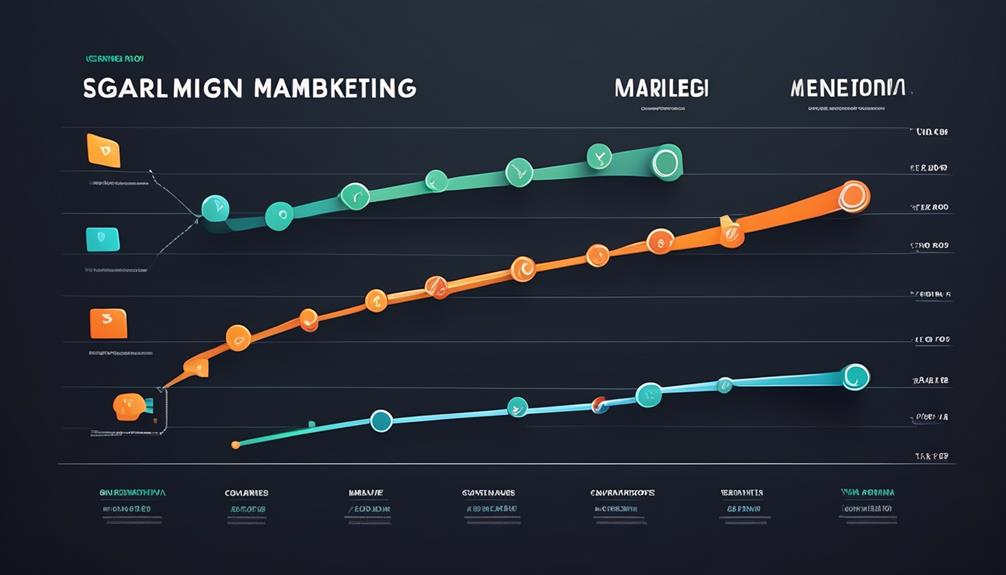
How can customer segmentation in email marketing lead to a significant improvement in Return on Investment (ROI)? By implementing customer segmentation in email marketing, businesses can experience an enhanced ROI through targeted promotions and increased customer engagement. Segmented email campaigns have been shown to result in higher open and click-through rates, ultimately contributing to an improved ROI. Additionally, email segmentation allows for personalized and relevant content, which in turn drives higher conversions and sales. Targeted emails based on segmentation also lead to better customer retention and increased lifetime value, ultimately boosting ROI. By focusing on customer segments with higher potential, email segmentation optimizes resources and maximizes ROI. To further illustrate the impact of customer segmentation on ROI, consider the following table:
| Benefits of Customer Segmentation in Email Marketing |
|---|
| Higher open and click-through rates |
| Personalized and relevant content |
| Better customer retention and increased lifetime value |
| Optimized resources and maximized ROI |
Enhanced Brand Reputation

By leveraging customer segmentation in email marketing, companies can strategically enhance their brand reputation through tailored and relevant content delivery. This approach allows for the delivery of more valuable and engaging content to subscribers, contributing to an enhanced brand image and reputation.
Here's how targeted email campaigns can significantly improve brand reputation:
- Demonstrating Understanding: Segmentation enables brands to demonstrate an understanding of customer needs and preferences, showing that the company is attentive and customer-centric.
- Personalized Communication: Targeted and personalized emails resulting from segmentation efforts can enhance brand perception, positioning the company as attentive to individual preferences, thus fostering trust and loyalty.
- Valuable Content Delivery: Segmentation allows for the delivery of more valuable and engaging content to subscribers, contributing to an enhanced brand image and reputation.
- Relevant Offerings: By leveraging segmentation to send targeted promotions and offers, brands can build a reputation for providing relevant and beneficial communications, further enhancing brand perception.
Frequently Asked Questions
Why Is Segmentation Important in Email Marketing?
Segmentation is important in email marketing because it allows us to tailor our messages to specific customer groups, increasing relevance and engagement. This targeted approach leads to higher open and click-through rates, improving overall campaign performance.
What Are the Benefits of Customer Segmentation?
Customer segmentation offers numerous benefits.
It improves campaign performance, increases deliverability, and enhances promotions. By targeting specific users with relevant content, we see higher open and click-through rates.
This approach also allows for more personalized and relevant messages, ultimately improving customer experience. Moreover, segmentation helps prevent unsubscribing due to excessive emails.
What Is the Biggest Advantage of Email Marketing?
The biggest advantage of email marketing is its ability to effectively target and engage customers. Segmentation allows us to tailor content to specific customer interests, leading to increased open rates, clicks, and conversions.
This personalized approach not only improves campaign performance and deliverability but also enhances the overall customer experience. By providing relevant and engaging content, email segmentation fosters customer loyalty and retention, ultimately driving sales and ROI.
What Are the 4 Benefits of Market Segmentation?
Segmentation offers several key benefits, including:
- Improved campaign performance
- Enhanced deliverability
- Targeted promotions
- A better customer experience
By tailoring content to specific segments, we see increased open rates, clicks, and conversions. Additionally, this approach helps improve sender reputation and deliverability.
Targeted promotions based on interests and behaviors lead to more effective marketing, ultimately boosting ROI.
– What Are the Key Advantages of Customer Segmentation Email Marketing?
Customer segmentation in email marketing is highly beneficial for businesses. By dividing your email list into targeted groups, you can personalize your messages and deliver content that is more relevant to each segment. This can lead to higher open rates, click-through rates, and ultimately, increased sales and customer satisfaction.
Conclusion
In conclusion, customer segmentation email marketing offers a range of benefits. These benefits include increased open rates and customer engagement, as well as higher conversions and enhanced brand reputation. By leveraging customer data and tailoring content to individual preferences, businesses can optimize their promotional strategies and improve their return on investment. This strategic approach to email marketing is essential for driving results and staying ahead in today's competitive market.
Bryn – AI Expert Writer Bryn is the wizard of words and AI at Influenctor. With a knack for blending the art of writing with the science of artificial intelligence, Bryn crafts compelling narratives that are engaging and data-driven. Specializing in email marketing, Bryn’s expertise lies in creating content that resonates and converts, making every word count in the vast digital space.
Segmented Email Campaigns
Effective Email List Segmentation Strategies for Marketers
Burst into the world of email list segmentation and discover the powerful strategies that will transform your marketing game.

Dividing an email list into segments is akin to creating a work of art; every brush of color uncovers the singular allure of the entire piece. As marketers, we recognize the significance of connecting with our audience through customized messages that align with their unique preferences and activities.
However, in the vast landscape of email marketing, how do we effectively navigate the terrain of segmentation to ensure our efforts yield the desired results?
Join us as we explore the intricate strategies and proven techniques that can elevate your email marketing game to new heights, driving engagement and conversions like never before.
Key Takeaways
- Email segmentation is crucial for targeting and personalizing campaigns, leading to higher engagement and conversion rates.
- Behavioral segmentation allows for personalized content delivery based on past interactions, improving the effectiveness of campaigns.
- Analyzing open rates and click-through rates helps refine email content and optimize send times, increasing the overall performance of campaigns.
- Targeting inactive subscribers through personalized re-engagement campaigns can improve overall email list engagement and conversion rates.
Understanding Email Segmentation
Understanding email segmentation is crucial for effectively targeting and personalizing email campaigns to maximize engagement and conversion rates. By segmenting your email list, you can tailor your marketing strategies to specific groups within your customer base. This allows for the creation of personalized emails that resonate with the unique needs and preferences of each segment.
When segmenting your email list, consider using buyer personas and segmentation ideas to nurture leads throughout the customer journey. This approach ensures that the right content is delivered to the right audience at the right time, increasing the likelihood of conversions.
Segmentation is the key to unlocking the full potential of your email marketing efforts. It's like having a conversation with each segment individually, rather than broadcasting a generic message to your entire list. This level of personalization and precision is what sets effective email campaigns apart.
Benefits of Segmentation

What benefits does segmentation bring to email marketing campaigns, and how can it enhance the overall effectiveness of our outreach efforts?
Email list segmentation in marketing offers numerous advantages. By dividing our email list into smaller segments, we can send more relevant, targeted content to our customers. This tailored approach increases the resonance of our emails, leading to higher engagement rates. Segmented campaigns have been shown to improve open and click-through rates, as the content is specifically tailored to the interests and needs of each segment.
Moreover, relevant content significantly increases the likelihood of recipients taking the desired action, ultimately leading to better conversion rates. Additionally, segmentation helps us avoid sending generic messages, reducing the chances of subscribers unsubscribing and thus decreasing unsubscribe rates. Furthermore, personalized emails not only improve customer satisfaction but also enhance customer loyalty, contributing to better customer retention.
Therefore, by sending segmented emails, we can deliver more personalized, targeted content that resonates with specific groups of subscribers, ultimately enhancing the effectiveness of our email marketing campaigns.
Demographic Segmentation
We're about to explore the effectiveness of demographic segmentation in email marketing.
Age-based segmentation allows us to tailor content that resonates with different age groups.
Gender-based segmentation enables us to craft messaging that speaks directly to the unique preferences and needs of different genders.
Age-Based Segmentation
By segmenting our email list based on age, we can tailor our content and offers to resonate with specific age groups, allowing for personalized communication and targeted messaging. Age-based segmentation is a crucial aspect of demographic segmentation for email marketing. It enables us to create segments based on different age ranges, ensuring that our emails are relevant and engaging for each group. To effectively segment your customers, it's essential to identify key age brackets and understand the preferences and behaviors associated with each group. Sending targeted emails to these segments based on age-specific interests and needs can significantly enhance engagement and conversion rates. Below is a table illustrating the significance of age-based segmentation in email marketing:
| Age Group | Characteristics |
|---|---|
| Millennials | Tech-savvy, value experiences |
| Gen X | Family-oriented, career-focused |
| Baby Boomers | Value security, traditional |
| Gen Z | Digital natives, socially conscious |
| Seniors | Value simplicity, health-focused |
Gender-Based Segmentation
Gender-based segmentation is a valuable strategy that allows marketers to tailor their email content to resonate with specific genders within their audience, leading to more targeted and relevant messaging. When implementing gender-based segmentation in email list segmentation strategies, it's essential to create separate segments according to the gender of your email recipients. This enables you to send the most relevant and personalized content to each group.
Marketers can use this strategy to understand and address the unique needs and behaviors associated with different genders, enhancing the effectiveness of their marketing efforts. By segmenting your list based on gender, you can craft campaigns that resonate with the diverse interests and characteristics of your male and female subscribers, ultimately driving higher engagement and conversion rates.
Behavioral Segmentation
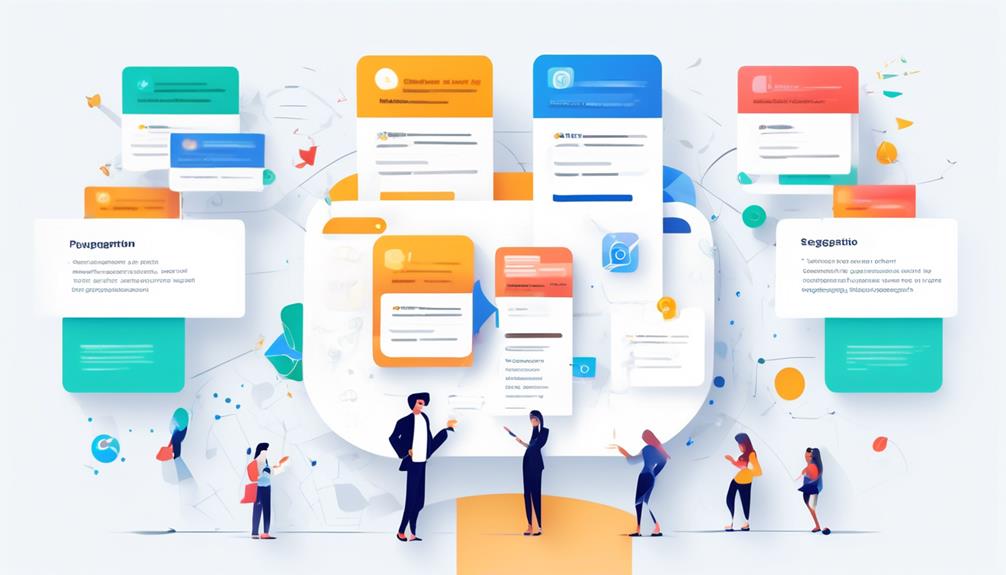
A powerful approach to enhancing email list segmentation is behavioral segmentation, which involves dividing the email list based on past interactions and behaviors such as purchase history, product usage, and website interactions. This valuable tool allows for personalized content delivery based on specific behaviors, increasing relevance and engagement.
By segmenting subscribers based on their behavior, marketers can send tailored emails that cater to individual preferences and interests, improving the effectiveness of email marketing campaigns. Behavioral segmentation enables targeted messaging to specific groups based on their past actions. This strategy helps in delivering the right message to the right audience at the right time, leading to higher conversions and engagement.
Marketers can use behavioral segmentation to send emails based on how recipients interact with their emails, ensuring that the content resonates with the recipient's interests. It's a strategic segmentation strategy that can significantly enhance the impact of email marketing campaigns and improve the overall experience for email recipients.
Email Engagement Level
Let's talk about how analyzing open rates can help us understand which subscribers are most engaged with our emails.
We can also explore how segmenting based on click-through rates can lead to more targeted campaigns.
Additionally, we'll discuss strategies for re-engaging inactive subscribers to boost overall engagement levels.
Open Rate Analysis
Open Rate Analysis is an essential tool for evaluating the engagement level of email subscribers, providing valuable insights into their interests and interactions with the content.
When analyzing open rates, we can identify trends and patterns, enabling targeted adjustments to improve engagement levels.
Segmentation based on open rates allows us to differentiate highly engaged subscribers and those needing re-engagement efforts, facilitating tailored communication.
Understanding open rates helps gauge the effectiveness of subject lines, content, and overall email strategy, leading to refined email content and optimized send times.
By utilizing open rate analysis, we can send more targeted and personalized emails, ultimately increasing the overall performance of our email campaigns.
This approach also contributes to enhancing the Net Promoter Score (NPS) by fostering stronger connections with email recipients.
Click-Through Rate Segmentation
As we aim to enhance our email marketing strategy, understanding the click-through rate segmentation becomes pivotal for effectively targeting subscribers based on their interaction levels with our emails. This segmentation strategy allows us to categorize email recipients into highly engaged and less engaged segments, enabling us to tailor our approach accordingly.
Highly engaged leads may receive exclusive content or offers, while less engaged ones may be re-engaged with personalized content. By analyzing click-through rates, we can gauge the effectiveness of our email campaigns and refine our strategies to boost engagement.
Utilizing click-through rate segmentation is the practice of delivering personalized and targeted messaging to improve overall email performance. This enables us to effectively segment our audience and deliver content that resonates, ultimately driving better results on our marketing platform.
Inactive Subscriber Targeting
Targeting inactive subscribers through personalized re-engagement campaigns is crucial for revitalizing their interest and increasing overall email list engagement.
When implementing inactive subscriber targeting, we focus on:
- Creating segments for highly engaged subscribers and those who rarely interact with emails.
- Tailoring specific re-engagement campaigns to inactive subscribers, aiming to bring them back into the active engagement fold.
- Reviving interest and interaction from subscribers who've become disengaged over time.
- Improving overall email list engagement and potentially increasing conversion rates.
Effective Segmentation Strategies

To effectively segment an email list, it is crucial to personalize content for each segment in order to increase engagement and conversion rates. By creating different email list segments based on target audience, we can use email list segmentation to send relevant emails, tailoring our content to the specific needs and interests of each segment. This email segmentation strategy allows us to use data to send more personalized and targeted communications, leading to higher open rates and improved customer satisfaction.
| Segment Based on Target Audience | Use Data to Send | Send Relevant Emails |
|---|---|---|
| Demographic, geographic, behavioral, and preference-based segmentation | Utilize segmentation tools and software | Employ dynamic content, behavioral triggers, and personalized recommendations |
Frequently Asked Questions
What Is Segmentation Strategy in Email Marketing?
Segmentation strategy in email marketing involves dividing the email list into smaller, targeted groups to send personalized and relevant content. It enables us to tailor email campaigns, leading to higher engagement and conversion rates.
Precise targeting ensures the right message reaches the right people at the right time. This strategy is essential for successful marketing campaigns, ensuring subscribers receive content that resonates with their interests and needs.
How Should I Segment My Email Lists?
When segmenting our email lists, we focus on personalized content to boost engagement. 72% of consumers say they only engage with personalized messaging.
We tailor our segments based on demographics, behavior, and interests, ensuring relevant content reaches the right audience.
We use dynamic content to adapt emails based on user behavior. By doing this, we see increased open and click-through rates, leading to higher conversions and customer satisfaction.
What Is the Most Effective Email Marketing Campaign Strategy?
The most effective email marketing campaign strategy involves segmentation to send targeted emails tailored to smaller groups, increasing relevance and engagement. This ensures the right message reaches the right people, leading to improved open and click-through rates and better conversion rates.
Strategies include demographic, geographic, and behavioral segmentation, as well as segmenting based on email engagement level, purchase history, and customer loyalty.
Tools for segmentation include built-in features in popular email service providers, CRM systems, marketing automation platforms, and third-party plugins and integrations.
Email segmentation also involves dynamic content, personalized recommendations, re-engagement campaigns, and personalized subject lines to enhance engagement and drive conversions.
Why Would a Marketer Segment Their Email Marketing Lists?
We segment our email marketing lists to deliver personalized and relevant content, increasing engagement and conversions.
Tailoring our messaging and offers to different audience segments improves the chances of resonating with recipients and driving desired actions.
By avoiding generic messages to our entire audience, we reduce the likelihood of unsubscribes and increase customer satisfaction.
Effective segmentation allows us to better understand our audience's preferences, behaviors, and needs, creating more targeted and effective marketing campaigns.
What are the Most Effective Email List Segmentation Strategies for Marketers?
When it comes to reaching the right audience with your email marketing campaigns, using effective email list segmentation strategies is key. By categorizing your subscribers based on their behaviors, demographics, or interactions with your brand, you can tailor your messages to their specific interests and preferences, resulting in higher engagement and conversions.
Conclusion
In conclusion, implementing effective email list segmentation is like having a secret weapon in our marketing arsenal. By understanding our audience and tailoring our content to their specific needs and interests, we can significantly boost our conversion rates and engagement levels.
With the right segmentation strategies in place, we've the power to deliver personalized and targeted messages that resonate with our subscribers, ultimately leading to the success of our email campaigns.
Bryn – AI Expert Writer Bryn is the wizard of words and AI at Influenctor. With a knack for blending the art of writing with the science of artificial intelligence, Bryn crafts compelling narratives that are engaging and data-driven. Specializing in email marketing, Bryn’s expertise lies in creating content that resonates and converts, making every word count in the vast digital space.
-

 Email Automation2 weeks ago
Email Automation2 weeks agoAutomated Email Marketing 101: A Beginner's Tutorial
-

 Email Warmup3 weeks ago
Email Warmup3 weeks agoWarm Follow-Up Email
-

 Email Design Hub1 month ago
Email Design Hub1 month ago3 Essential Tools for Email Marketing Design Success
-

 Email Marketing2 weeks ago
Email Marketing2 weeks agoWhat Is Email Marketing Advantages and Disadvantages
-

 Email Marketing3 weeks ago
Email Marketing3 weeks agoWhy Email Marketing Is Effective
-

 Email Template2 weeks ago
Email Template2 weeks agoCrafting the Perfect Book Club Invitation Email Template
-

 Email Marketing2 weeks ago
Email Marketing2 weeks agoDoes Email Marketing Work in 2024
-

 Search Engine Optimization2 weeks ago
Search Engine Optimization2 weeks agoSEO Checklist: Enhance Your Site’s Performance
















